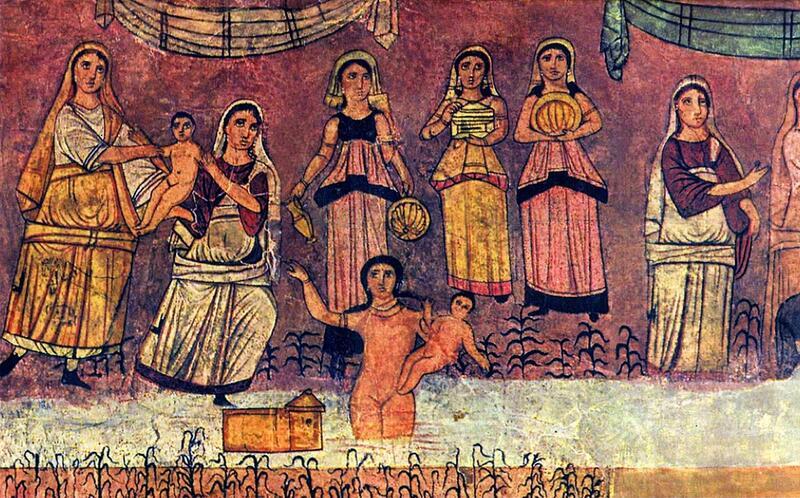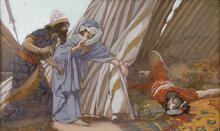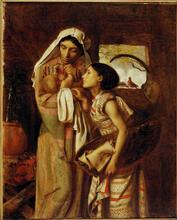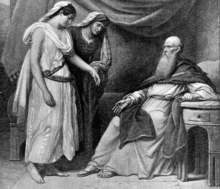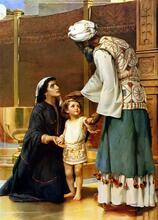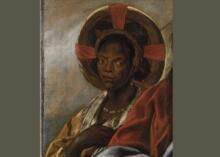Daughter of Pharaoh: Midrash and Aggadah
The rabbis depict the daughter of Pharaoh as a righteous figure who did not follow her father’s wicked ways, but rather converted and ceased worshiping idols. By miraculously rescuing Moses, she was inadvertently responsible for the redemption of Israel, for which she was rewarded with a new name, Bithiah (daughter of God), identifying her with the genealogy in Chronicles. She was highly praised by the Rabbis, and the midrash includes her among the devout women converts and those who entered the Garden of Eden while still alive.
The daughter of Pharaoh did not follow her father’s wicked ways, but rather converted and ceased worshiping idols. She was highly praised by the Rabbis, and the A type of non-halakhic literary activitiy of the Rabbis for interpreting non-legal material according to special principles of interpretation (hermeneutical rules).midrash includes her among the devout women converts: Hagar, Asenath, Zipporah, Shiphrah, Puah, the daughter of Pharaoh, Rahab, Ruth, and Jael wife of Heber the Kenite (Midrash Tadshe, Ozar ha-Midrashim [ed. Eisenstein], p. 474). The midrash specifically praised the daughter of Pharaoh for her rescue of Moses, thereby aiding in the exodus of all the Israelites from Egypt. Moses was raised in her home, by a woman who believed in God. She radiated warmth and loved him as if he were her own son, and accordingly was richly rewarded: she married Caleb son of Jephunneh and joined the people of Israel. Some midrashim attest to her longevity and claim that she entered the Garden of Eden while still alive.
The Daughter of Pharaoh Is Bithiah
The midrash calls the daughter of Pharaoh “Bithiah,” identifying her with the woman mentioned in I Chron 4:18: “And his Judahite wife bore Jered father of Gedor, Heber father of Soco, and Jekuthiel father of Zanoah. These were the sons of Bithiah daughter of Pharaoh, who Mered married.” The “Bithiah daughter of Pharaoh” mentioned in this verse is one of the two wives of Mered, who was descended from Caleb son of Hezron, who apparently was of Judahite extraction. The Rabbis found the name bat-yah to be fitting for the daughter of Pharaoh in the Book of Exodus, since she (unwittingly) realized the divine plan when she kept alive the rescuer of Israel. The midrash relates that the daughter of Pharaoh received her new name of Bithiah (bat-yah; literally, the daughter of God) from God as reward for her actions. God told her: “Moses was not your son, yet you called him your son; you are not My daughter, but I call you My daughter” (Lev. Rabbah 1:3). The verse in Chronicles served as the basis for various expositions concerning the daughter of Pharaoh (see also below). The Rabbis ask why Chronicles refers to her as “his Judahite [or, Jewish] wife,” since she was an Egyptian. They answer that Bithiah received this appellation because she repudiated idolatry (BT Lit. "scroll." Designation of the five scrolls of the Bible (Ruth, Song of Songs, Lamentations, Ecclesiastes, Esther). The Scroll of Esther is read on Purim from a parchment scroll.Megillah 13a).
The Daughter of Pharaoh Comes Down to Bathe in the Nile
The midrashim about the story of Moses’s rescue are replete with wondrous acts and miracles, that are meant to graphically illustrate the threat to the infant’s life and the divine intervention that was manifested in his rescue. The reader gains the impression that Moses was not like all men, and that his qualities were already evident while still a child. The miraculous deliverance of the infant Moses symbolizes the future salvation of the people of Israel from Egypt, where miraculous events would occur, as well.
The Torah she-bi-khetav: Lit. "the written Torah." The Bible; the Pentateuch; Tanakh (the Pentateuch, Prophets and Hagiographia)Torah relates that the daughter of Pharaoh found Moses when she went down to bathe in the Nile (Ex. 2:5). In the midrashic expansion, she did not go there to bathe, but to cleanse herself from the idols of her father’s house (that is, to perform the immersion of conversion) (BT Megillah 13a). This exegesis illuminates the spiritual qualities of the daughter of Pharaoh, by merit of which she was chosen to be the one to find and raise Moses.
The Rabbis magnify the test to which the daughter of Pharaoh was put when she saw the ark. In the midrashic account, when her handmaidens saw that she intended to rescue Moses, they attempted to dissuade her, and persuade her to heed her father. They said to her: “Our mistress, it is the way of the world that when a king issues a decree, it is not heeded by the entire world, but his children and the members of his household do observe it, and you wish to transgress your father’s decree?” Immediately, Gabriel appeared and beat them to the ground, and they died (BT Suspected adulteressSotah 12b). These handmaidens represent the internal voice of the daughter of Pharaoh, who might have been undecided as to whether she should disobey her father’s edict. The angel Gabriel removes this obstacle and reinforces her resolve to draw Moses forth from the Nile.
An additional miracle was performed when the ark was drawn forth from the water. Ex. 2:5 attests: “and she sent her slave girl [amatah] to fetch it.” The Rabbis have different understandings of the word amatah, which has two possible meanings: “her slave girl,” or “her hand.” According to one view, she sent her slave girl to draw forth the ark. Although the angel Gabriel had killed her handmaidens (see above), he left her one, because it is not customary for the daughter of a king to stand unattended, and it was this slave girl who was sent to rescue Moses from the Nile (as was fitting for the daughter of royalty). In another hermeneutical approach, that understands amatah as “her hand,” the daughter of Pharaoh herself drew forth Moses from the river. Since it was not meet for the daughter of Pharaoh to trouble herself and go down into the river to try and catch the floating ark, a miracle was performed for her, and her arm stretched out until it could reach the ark (Ex. Rabbah 1:23); one tradition has her arm extending to a length of sixty cubits (Lekach Tov, [Buber ed.] 2:10). This exegesis emphasizes the personal involvement of the daughter of Pharaoh in Moses’s rescue, as she herself attests in Ex. 2:10: “I drew him out of the water.” In the fresco from Dura-Europos (above), the daughter of Pharaoh stands naked in the water and draws Moses from the Nile. This painting supports the hermeneutical approach that "amatah" literally means her hand.
In the Torah’s account of what happened after the ark was drawn forth (Ex. 2:6): “When she opened it, she saw that it [va-tire-hu] was a child […]. She took pity on it.” The Rabbis ask what caused the daughter of Pharaoh to take pity on Moses and keep him alive, contrary to her father’s command. The midrash replies that she saw the Shekhinah (the Divine Presence) with him, and the wording “va-tire-hu” alludes to the name of God (Ex. Rabbah 1:24). Another approach is based on the continuation of the verse, that relates that the child’s weeping motivated the daughter of Pharaoh: “She saw that it was a child, a boy crying. She took pity on it.” The Rabbis maintain that divine intervention was needed for the infant to cry, which they learn from a close reading of v. 6. The beginning of the verse refers to Moses as a “child [yeled],” and then calls him a “boy [na’ar],” from which the Rabbis learn that Moses was a yeled, that is, an infant, but he conducted himself as a na’ar (an older child). Thus, when the daughter of Pharaoh opened the ark, Moses, unlike other babies, did not cry. The angel Gabriel immediately came and hit Moses so that he would cry, thereby arousing the compassion of the daughter of Pharaoh (Ex. Rabbah 1:24). Another tradition claims that the daughter of Pharaoh suffered from leprosy and she went down to bathe in the water to be cured of her disease. When she touched Moses’s ark, she was miraculously cured, leading her to take pity on the child and love him so strongly (Ex. Rabbah 1:23).
The Torah relates that when the daughter of Pharaoh saw Moses, she declared (Ex. 2:6): “This must be a Hebrew child,” to which the midrash adds that Moses was born circumcised (Ex. Rabbah 1:20); when she saw that the infant was circumcised, she realized that he was a Hebrew child (Ex. Rabbah 1:24). Another midrash explains that when the daughter of Pharaoh made this statement, she was unconsciously prophesying: “This” child fell into the Nile, but none other of the children of the Hebrews did so (she prophesied that Moses was the last Hebrew child to be cast into the river). She was correct, because Pharaoh’s astrologers saw in the stars that the one destined to save Israel would be punished through water, and they therefore had Pharaoh issue his decree (Ex. 1:22): “Every boy that is born you shall throw into the Nile,” in order to kill the deliverer. Once Moses had been placed in the water, the astrologers said: “We no longer see that sign,” and they canceled the decree (BT Sotah 12b). Consequently, the daughter of Pharaoh was prophetic, because Pharaoh’s decree was revoked after Moses had been placed in the water. The midrash adds that the astrologers were correct to a certain degree, since Moses would be punished by water when he sinned at the Waters of Meribah (Num. 20:7–13).
A Hebrew Nurse
In the midrashic depiction, the daughter of Pharaoh saw that Moses was hungry when she drew him forth from the Nile. She went around with him to all the Egyptian women, but Moses was not willing to nurse from any of them. Moses said: “The mouth that will speak with God will not suckle something impure [the milk of non-Jews].” Accordingly, Miriam came and offered the daughter of Pharaoh her mother Jochebed, who was “a Hebrew” (Ex. 2:7) (BT Sotah 12b). Following another interpretation, Moses rejected the breasts of the Egyptian women because he said: “God will speak with me. The next day the Egyptian women would say: ‘I nursed the one who speaks with the Shekhinah’” (Ex. Rabbah 1:25).
The daughter of Pharaoh asked of Jochebed (Ex. 2:9): “Take [helikhi] this child and nurse it for me,” which, according to the Rabbis, was an instance of unwitting prophecy, since the word “helikhi” concealed the truth—“shelikhi hu [he—the infant—is yours]” (Ex. Rabbah 1:25). Jochebed nursed Moses for twenty-four months (Ex. Rabbah 1:26). The midrash asserts that although Jochebed gave birth to Moses, he is called the son of Bithiah the daughter of Pharaoh, because she raised him (BT Sotah 19b).
The Daughter of Pharaoh Raises Moses
The midrash tells that the daughter of Pharaoh would kiss and hug Moses as if he were her own son, and she would not take him out of the royal palace. Because of his beauty, everyone desired to see him, and no one who saw him could tear his eyes away. Moses’s life was in danger, despite the daughter of Pharaoh’s guarding of the infant. One time Pharaoh held Moses and hugged him. Moses took Pharaoh’s crown from the monarch’s head and put it on his own, as he would later do when he grew up. Pharaoh’s magicians, who were sitting there, explained: “We fear that this child will take your crown and place it on his own head, lest this be the one who we prophesy will seize the kingdom from you.” Some of the magicians said to kill the child, and some said to have him burnt. Jethro was sitting among them (as one of the magicians). He told them: “This child is witless. In order to test him, set before him two bowls, one containing gold, and the other, a coal. If he stretches his hand to the coal, he is witless and does not deserve to die; but if he stretches his hand to the gold, he did this with intelligence, and he is to be put to death.” They immediately set before him the gold and the coal and Moses put forth his hand to take the gold, but Gabriel came and pushed his hand away. Moses took the coal and put his hand, with the coal, in his mouth. His tongue was burnt, thus causing him to be (Ex. 4:10) “slow of speech and slow of tongue” (Ex. Rabbah 1:26). The Rabbis observe that the daughter of Pharaoh raised in the palace the one who would eventually bring all manner of troubles upon her father as punishment for the subjugation of Israel, as is said in Ezek. 28:18: “So I made a fire issue from you, and it has devoured you,” thus symbolizing the manner in which the future redemption would occur.
The names of the daughter of Pharaoh’s six offspring in I Chron. 4:18 are expounded as six different appellations for Moses: “And his Judahite wife bore Jered[,] father of Gedor, Heber[,] father of Soco, and Jekuthiel[,] father of Zanoah.” The midrash notes that she did not actually give birth to him, as this verse states, but only raised him, from which the Rabbis learn that anyone who raises an orphan in his house is accounted by Scripture as if he was the child’s birth parent (BT Megillah 13a).
Another midrash lists ten names that were given to Moses: Jered, Avi- [father of] Gedor, Heber, Avi-Soco, Jekuthiel, Avi-Zanoah, Tobijah, Shemaiah, Levi, and Moses. God told him: “By your life, of all the names by which you are called, I will call you only by the name given you by Bithiah the daughter of Pharaoh” (Lev. Rabbah 1:3). This teaches of the reward given to those who engage in acts of lovingkindness. The daughter of Pharaoh acted in such a manner with Moses, and was rewarded by the Torah using the name that she gave Moses; nor did God call him by any other name (Ex. Rabbah 1:26).
The Reward of the Daughter of Pharaoh
The Rabbis applied to the daughter of Pharaoh the verse from the “Woman of Valor” poem “She sees that her business thrives; her lamp never goes out at night” (Prov. 31:18). In the midrashic exposition, the “night” in this verse is that of the plague of the firstborn, in which all the firstborn of Egypt died. The female firstborn also died in this plague, with the exception of the daughter of Pharaoh. Despite her being a firstborn, Moses was an advocate for her and she was saved by merit of his prayer. Solomon therefore declared (Prov. 31:18): “She sees that her business thrives [ki tov],” since “ki tov” is an appellation for Moses, of whom it is said (Ex. 2:2): “she saw how beautiful [ki tov] he was.” “Her lamp never goes out at night,” because she did not die that night, of which it is said (Ex. 12:29): “In the middle of the night” (Pesikta de-Rav Kahana, Va-Yehi Ba-Hazi Ha-Laylah [“In the middle of the night”] [ed. Mandelbaum] 7:7; Ex. Rabbah 18:3).
The Rabbis deduced from I Chron. 4:18: “whom Mered married” that the daughter of Pharaoh was married to Caleb son of Jephunneh. They further maintain that he was given the name “Mered” because he rebelled (marad) against the counsel of the spies (when they spoke ill of the land of Canaan: Num. 13–14). God said: “Let Caleb, who rebelled against the counsel of the spies, marry the daughter of Pharaoh, who rebelled against the idols of her father’s house” (BT Megillah 13a).
The midrash asserts that Bithiah did not die, but was among those who entered the Garden of Eden while still alive, as did Enoch, Serah daughter of Asher, Elijah, the three sons of Korah, King Hiram of Tyre, Jabez, Jonadab son of Rahab and his descendants, Ebed-melech the Ethiopian, Abraham’s servant Eleazar, the slave of R. Judah ha-Nasi, and R. Joshua ben Levi (Kallah Rabbati 3:23; Masekhet Derekh Erez 1:18; for the various traditions, see L. Ginzberg, Legends of the Jews, vol. 5, pp. 95–96 n. 67). She was so privileged because she cared for Moses (i.e., rescued him and raised him) (Midrash Eshet Hayil 31:15). Another exegetical tradition has God saying: “Since this one brought salvation to Israel and brought them forth to life, I shall prolong her life. I shall reward this one, who left her father’s royal house and adhered to Israel” (Kallah Rabbati 3:23). This midrash attributes the salvation of all Israel to the daughter of Pharaoh, because she saved Moses from death, and thereby facilitated the redemption of Israel from Egypt by means of their leader Moses.

